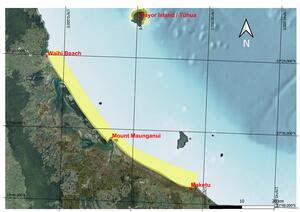An aerial survey along the Bay of Plenty coastline aims to create detailed 3D maps to help inform communities about the risks of coastal flooding and provide insights about marine habitat.
Toitū Te Whenua Land Information New Zealand (LINZ) is surveying the coast from Maketu to Waihi Beach using LiDAR (light detection and ranging) technology fitted to a small plane this week.
The technology works by sending laser light pulses to the ground and seabed to determine the distance between the two, which enables high detail mapping of the shape of the land and seafloor.
LINZ Senior Geospatial Specialist Bradley Cooper says the data collected will be used to understand the coastal zone in this area and can be used for tsunami and inundation modelling as well as coastal processes and marine habitats.
“We expect many locals will notice the low-flying plane as it will be tracking back and forth along the coast in a grid pattern.
“It needs to fly at a relatively low altitude to map the shape of the land and seabed in detail.
“As well as the coast between Maketu and Waihi Beach, including Mount Maunganui, we will also be surveying Mayor Island / Tūhua.”

Originally the work had been planned to take place in Southland, however bad weather down there meant we needed to quickly change the location to get the best out of the trial and so we’ve moved to the bay instead.
Fugro is undertaking this survey on behalf of LINZ during daylight hours. Fugro has extensive experience working throughout New Zealand and overseas using the latest hydrographic surveying tools and technology.
They will survey to a seabed depth of up to 20m to create detailed 3D maps of the seafloor and coastal zone.
Information from the survey will be made available later in the year through the online LINZ Data Service to support wider research into the coastal environment.
Media contact
Email: media@linz.govt.nz